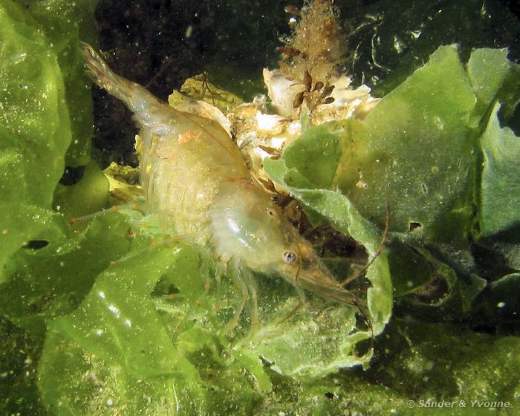Sea-lettuce, Ulva lactuca
Sea-lettuce is a green seaweed of rocky shores of all the sea's and oceans. This seaweed forms dense clumps of membranous blades, only two cells thick. These blades or thallus resemble lettuce leaves and can grow one meter long. This is an incredible fast growing seaweed, reaching a growth rate of 40% a day in optimal conditions. Sea Lettuce is bright green and is often seen on the beaches or free floating on the waves. Sea lettuce is edible and attract the attention of scientists as a very usable source of large scale seafood.
Sea-lettuce as a food
Sea-lettuce has a lightly salty sea flavour taste, much like salty spinach. Sea lettuce is an important part of Korean and Japanese cuisine. In Japan it is used to make Suhsi, it replaces nori (Porphyra), the most popular seaweed in sushi.
sea-Lettuce and wastewater
High nitrate levels can be removed from brackish wastewaters produced by agricultural runoff or fish farms, like wastewater produced by salmon fish farms. This is a win-win situation: the sea lettuce reaches an unbelievable growing rate and can be harvested, the wastewater is cleaned.

A young Atlantic cod resting ob Sea-lettuce. Atlantic cod are demersal fish which prefer sea bottoms. A nice photo of John de Jong, on Jojodive.
Sea-lettuce is very resistant against pollution.
Sea-lettuce is a symbiotic seaweed
The Sea-lettuce seaweed has a symbiotic relation with the marine bacterium YM2-23: this bacterium produces "thallusin". Thallusin induces normal germination and morphogenesis of green macroalgae. . It is well known that sea-lettuce lose its natural morphology during cultivation under aseptic conditions and during long-term cultivation in nutrient-added seawater and adopt an unusual form without thallusin. bron: Isolation of an Algal
Morphogenesis Inducer from a Marine Bacterium
Yoshihide Matsuo1, e.a.

A prawn between the leaves of sea-lettuve.
A photo made by Sander, Sander.

Green algae of the Northern Atlantic and Artic Ocean and North sea, source: P. Kuckuck 1933, Wat vindt ik aan het strand, vert 5 de druk
1 sea lettuce or ulva lactuca
2 Ulvopsis grevillei or Monostroma grevillei
3 Stone Hair or Link confetti or Entermorpha intestinalis
4 Enteromorpha linza or ulva linza
5 Enteromorpha compressa
6 Spongy Weed or Spongomorpha aeroginosa
7 Green Tarantula Weed or Acrosiphonia arcta
8 Common Green Branched Weed or Cladophora rupestris
9 Flax Brick Weed or Caetomorpha linum
10 Evenly Branched Mossy Feather Weed or Bryopsis plumosa
11 green sea fingers, dead man's fingers,sponge seaweed or Codium fragile
P. Kuckuck
Dr Paul Kuckuck is the writer of the book "Der Strandwanderer".
The first edition started in 1905, the last one in 1977.On this website you can find these illustrations :
barnacles
the sea slater
starfish
light-bulb tunicate
Whelks, limpets and periwinkles
Sponges and sea anemones
Cockles
sea beech
Oarweed
teredo worm or shipworm
hydrozoids
sea-lettuce or ulva
decomposing leaves as these produce large quantities of hydrogen sulphite (upper, middle and lower shores). Its thallus or frond is a thin bright-green translucent sheet of varied shape anchored by a holdfast and sometimes a short stalk (stipe) though in some locations this seaweed survives as a free-floating weed. Size varies from 5 to 5o cm, sometimes over one metre in length. The thallus is only two cells thick. Ulva species are aptly called sea lettuce. These green seaweeds may form dense clumps of membranous blades, only two cells thick, that resemble lettuce leaves. The sea lettuce Ulva is probably the most common green seaweed on rocky shores a section through an Ulva frond. Two sheets of closely spaced photosynthetic cells make up the frond (Ulva is said to be distromatic). Each cell has a single cup-shaped chloroplast which is parietal (lies in the margin of the cell) and during the day is positioned facing the surface, to intercept the sunlight for photosynthesis. At night the chloroplasts move, typically sitting at one of the long edges of the cell. Some of the cells, especially those in the stalk, give out multinucleate hyphal-like appendages called rhizoids, which strengthen the stalk. For anyone who has ever been down to a rocky seashore during low tide, one of the more notable features is the many seaweeds that may blanket the lower intertidal. Yes, seaweeds (or marine algae as they are often called) are that slippery stuff growing attached to the rocks that make the beach smell the way it does. Ulva and Enteromorpha are fast growing opportunistic seaweeds that have a wide salt and temperature tolerance. These features enable them to rapidly colonize any part of the rocky seashore if the conditions are right. They are often very abundant high up the shore where desiccation stress is the primary factor controlling seaweed distribution. Under sheltered conditions, Ulva and Enteromorpha species may be the only seaweeds to occupy entire high shore tide pools with Ulva plants often attaining lengths in excess of half a meter. When areas of the seashore become disturbed, these are the seaweeds that would be the first to appear because of their ability to rapidly colonize freed space. Ulva is a genus of algae that includes species that look like bright green sheets and live primarily in marine environments. They can also be found in brackish water, particularly estuaries. They live attached to rocks in the middle to low intertidal zone, and as deep as 10 meters in